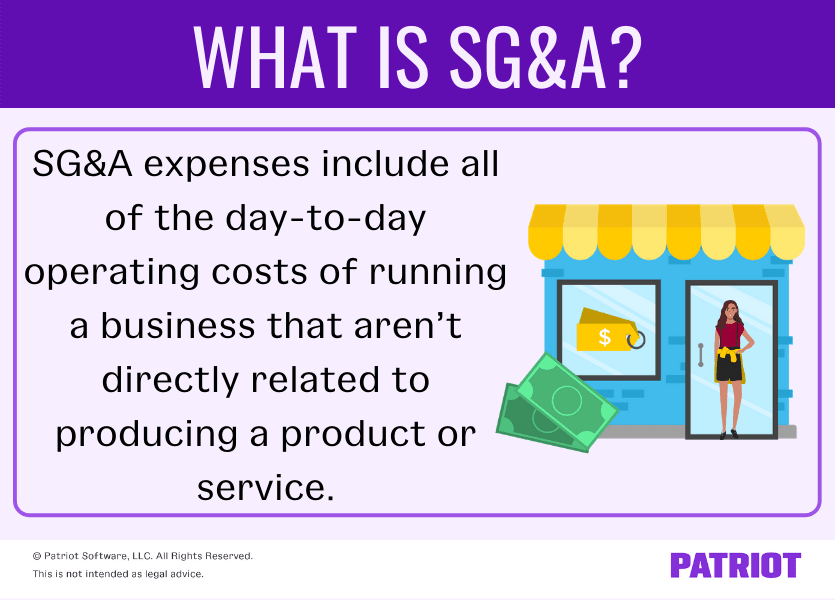Your business incurs all kinds of expenses during day-to-day operations. From payroll expenses to selling, general, and administrative expense (aka SG&A), there are a number of costs you need to pay attention to. But, what is SG&A exactly?
What is selling, general, and administrative expense?
SG&A expenses include all of the day-to-day operating costs of running a company that aren’t directly related to producing a product or service (i.e., non-production costs). A business’s SG&A is the sum of all direct and indirect selling expenses and all general and administrative (G&A) costs.
Monitoring your company’s SG&A can show you where you need to cut costs. If you’re struggling to keep profits up, make a profit, or notice an increase in expenses, you may need to decrease your SG&A costs.
Operating Expenses vs. SG&A
If you’re familiar with operating expenses, you might be wondering what the difference is between SG&A and operating costs.
Operating costs (OPEX) are expenses companies incur during normal operations. An operating expense is an ongoing cost of running a business. Operating expenses include all of the expenses that aren’t covered under cost of goods sold, such as rent, equipment, and marketing.
OPEX and SG&A expenses are generally one and the same. They both consist of costs that are not included in the COGS.
The only real difference between operating expenses and SG&A is how you record them on the income statement. Some businesses prefer to list SG&A as a subcategory of operating expenses on the income statement. Other companies may prefer to separate selling expenses from the G&A costs on the financial statement instead.
The way you list your SG&A and operating expenses on your income statement is completely up to you.

Types of SG&A expenses
So, what’re the types of selling, general, and administrative expenses?
Well for starters, you can break selling expenses down into direct and indirect costs of selling a product. Direct expenses occur when you sell a product, and they include shipping supplies and delivery charges. Indirect selling expenses include costs you incur before or after a sale, like marketing, advertising, promotional expenses, travel costs, and salaries for salespeople (if applicable).
In short, direct costs are directly related to the product being sold, while indirect costs are what you spend money on to earn sales.
The G&A part of the selling, general, and administrative expense include the day-to-day costs a business must pay to operate. Here are a few examples of general and administrative costs:
- Rent or mortgage
- Utilities
- Insurance
- Salaries of certain departments
- Legal fees
- Accounting costs
- Office supplies
How to calculate SG&A
Calculating SG&A is pretty straightforward. To calculate selling, general, and administrative expenses, use the SG&A formula:
SG&A = Selling Expenses + General & Administrative Expenses
Again, your selling expenses can include both direct and indirect costs of selling a product. On the other hand, your business’s general and administrative expenses include day-to-day costs (e.g., rent, utilities, etc.).
SG&A example
Say your business, Company ABC, pays $1,100 in rent, $250 for utilities, $150 for insurance, $500 for marketing, $3,000 in salaries for salespeople, $3,500 in other salaries, and $100 for office supplies per month.
To calculate your company’s SG&A expenses, separate your selling expenses and G&A expenses. That way, you know how much money you’re spending in selling expenses and how much in general and administrative expenses. Then, add them together. To simplify things, you can also just add together all of your expenses to find your total SG&A expense for the period.
Selling expenses:
- Marketing: $500
- Salaries for salespeople: $3,000
- Total: $3,500
General and administrative expenses:
- Rent: $1,100
- Utilities: $250
- Insurance: $150
- Other salaries: $3,500
- Office supplies: $100
- Total: $5,100
SG&A = $3,500 + $5,100
Company ABC’s total selling, general, and administrative expenses for the period is $8,600.
Recording SG&A in your accounting books
Report SG&A on your income statement. Your income statement reports your business’s profits and losses over a specific period of time.
How you record SG&A in your books depends on your preference. Some businesses include it as a subcategory of operating expenses on their income statement. Others may decide to keep it separate and on its own line.
Here’s an example of what recording SG&A in accounting may look like:
| Revenue | $X |
| Cost of Goods Sold | $X |
| Gross Profit | $X |
| Operating Expenses | |
| Selling, General, & Administrative | $X |
| Research & Development | $X |
| Depreciation | $X |
| Total Expenses | $X |
| Operating Profit | $X |
| Net Profit | $X |
Here’s another example of what SG&A might look like in your business’s books:
| Revenue | $X |
| Cost of Goods Sold | $X |
| Gross Profit | $X |
| Expenses | |
| General & Administrative | $X |
| Marketing | $X |
| Research & Development | $X |
| Total Expenses | $X |
| Net Profit | $X |
Are you tracking the transactions you need to calculate your selling, general, and administrative expense? Patriot’s online accounting software makes it a breeze to record business income and expenses. Plus, we offer free, USA-based support. Start your free trial today!
This is not intended as legal advice; for more information, please click here.
